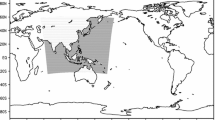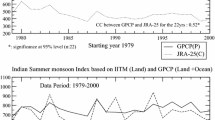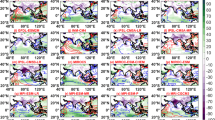Abstract
A successful simulation of the western North Pacific summer monsoon needs a regional ocean–atmosphere coupled model (ROAM). How the performance of ROAM relies on the oceanic component model remains unknown. In this study, the authors investigated the effects of different oceanic components on the simulation of western North Pacific (WNP) summer monsoon in a ROAM. Three cases of simulations were performed, viz. the summer of 1998 (El Niño decaying phase), 2004 (El Niño developing phase), and 1993 (the non-ENSO phase). Results show that the coupled simulations for different ENSO phases exhibit improvements in the simulation of location of Meiyu rainband and spatial distribution of monsoon low-level flow over WNP, whereas the systemic cold biases of sea surface air temperature are further increased. The coupled simulations with different oceanic components show similar performance, which is not ENSO phase dependent. For the case of the summer of 1998, a slightly stronger western Pacific subtropical high and colder sea surface air temperature are found in the simulation with colder sea surface temperature (SST) biases. The colder SST biases are partly contributed by the ocean dynamics processes because the sea surface net flux favors a warmer SST. This study suggests that the dependence of performance of ROAM over WNP on oceanic models is much weaker than that on atmospheric models.








Similar content being viewed by others
References
Wang B, Kang IS, Lee JY (2004) Ensemble simulations of Asian-Australian monsoon variability by 11 AGCMs. J Clim 17:803–818
Wu R, Kirtman BP (2005) Roles of Indian and Pacific Ocean air–sea coupling in tropical atmospheric variability. Clim Dyn 25:155–170
Zhou TJ, Wu B, Wang B (2009) How well do atmospheric general circulation models capture the leading modes of the interannual variability of the Asian-Australian monsoon? J Clim 22:1159–1173
Zhou TJ, Wu B, Scaife AA et al (2009) The CLIVAR C20C project: which components of the Asian-Australian monsoon circulation variations are forced and reproducible? Clim Dyn 33:1051–1068
Wang B, Ding QH, Fu XH et al (2005) Fundamental challenge in simulation and prediction of summer monsoon rainfall. Geophys Res Lett 32:L15711. doi:10.1029/2005GL022734
Kug JS, Kang IS, Choi DH (2008) Seasonal climate predictability with tier-one and tier-two prediction systems. Clim Dyn 31:403–416
Zou LW, Zhou TJ (2011) Sensitivity of a regional ocean–atmosphere coupled model to convection parameterization over western North Pacific. J Geophys Res 116:D18106. doi:10.1029/2011JD015844
Zou LW, Zhou TJ (2012) Development and evaluation of a regional ocean–atmosphere coupled model with focus on the western North Pacific summer monsoon simulation: Impacts of different atmospheric components. Sci China Earth Sci 55:802–815
Ren XJ, Qian YF (2005) A coupled regional air–sea model, its performance and climate drift in simulation of the East Asian summer monsoon in 1998. Int J Climatol 25:679–692
Yao SX, Zhang YC (2008) Regional coupled air–sea model simulation of China summer precipitation. Acta Meteorol Sin 66:131–142 (in Chinese)
Li T, Zhou GQ (2010) Preliminary results of a regional air–sea coupled model over East Asia. Chin Sci Bull 55:2295–2305
Fang YJ, Zhang YC, Tang JP et al (2010) A regional air–sea coupled model and its application over East Asian in the summer of 2000. Adv Atmos Sci 27:583–593
Ratnam JV, Giorgi F, Kaginalkar A et al (2009) Simulation of the Indian monsoon using the RegCM3-ROMS regional coupled model. Clim Dyn 33:119–139
Pal JS, Giorgi F, Bi XQ et al (2007) Regional climate modeling for the developing world: the ICTP RegCM3 and RegCNET. Bull Am Meteorol Soc 88:1395–1409
Mellor GL (2004) Users guide for a three-dimensional, primitive equation, numerical ocean model. Program in atmospheric and oceanic sciences. Princeton University, Princeton
Chu PC, Chang CP (1997) South China Sea warm pool in boreal spring. Adv Atmos Sci 14:195–206
Qian YF, Zhu BC, Wang QQ (1998) A computational scheme of horizontal pressure gradient in ocean model with σ coordinate system. J Nanjing Univ (Nat Sci) 134:691–700 (in Chinese)
Mellor GL, Yamada T (1982) Development of a turbulence closure model for geophysical fluid problems. Rev Geophys Space Phys 20:851–875
Liu HL, Lin PF, Yu YQ et al (1999) The baseline evaluation of LASG/IAP climate system ocean model (LICOM) version 2. Acta Meteorol Sin 26:318–329
Jin XZ, Zhang XH, Zhou TJ (1999) Fundamental framework and experiments of the third generation of IAP/LASG world ocean general circulation model. Adv Atmos Sci 16:197–215
Zhang XH, Yu YQ, Yu RC et al (2003) Assessments of an OGCM and the relevant CGCM part I: annual mean simulations in the tropical ocean. Chin J Atmos Sci 27:649–970 (in Chinese)
Liu HL, Zhang XH, Li W et al (2004) An eddy-permitting oceanic general circulation model and its preliminary evaluations. Adv Atmos Sci 21:675–690
Canuto VM, Howard A, Cheng Y et al (2001) Ocean turbulence. Part I: one-point closure model-momentum and heat vertical diffusivities. J Phys Oceanogr 31:1413–1426
Canuto VM, Howard A, Cheng Y et al (2002) Ocean turbulence. Part II: vertical diffusivities of momentum, heat, salt, mass, and passive scalars. J Phys Oceanogr 32:240–264
Zou LW, Zhou TJ (2013) Can a regional ocean–atmosphere coupled model improve the simulation of the interannual variability of the western North Pacific summer monsoon? J Clim 26:2353–2367
Kanamitsu M, Ebisuzaki W, Woollen J et al (2002) NCEP-DOE AMIP-II reanalysis (R-2). Bull Am Meteorol Soc 83:1631–1643
Levitus S (1982) Climatological atlas of the world ocean. NOAA Prof paper 13, and 17 microfiche
Locarnini RA, Mishonov AV, Antonov JI et al (2006) World ocean atlas 2005, vol 1: temperature. In: Levitus S (ed) NOAA Atlas NESDIS 61. U.S. Government Printing Office, Washington, DC
Antonov JI, Locarnini RA, Boyer TP et al (2006) World ocean atlas 2005, vol 2: salinity. In: Levitus S (ed) NOAA Atlas NESDIS 62. U.S. Government Printing Office, Washington, DC
Reynolds RW, Rayner NA, Smith TM et al (2002) An improved in situ and satellite SST analysis for climate. J Clim 15:1609–1625
Wu B, Zhou TJ, Li T (2009) Contrast of rainfall-SST relationships in the western North Pacific between the ENSO-developing and ENSO-decaying summers. J Clim 22:4398–4405
Huffman GJ, Adler RF, Bolvin DT et al (2007) The TRMM multisatellite precipitation analysis (TMPA): quasi-global, multiyear, combined-sensor precipitation estimates at fine scales. J Hydrometeorol 8:38–55
Yu L, Jin X, Weller R (2008) Multidecade global flux datasets from the objectively analyzed air–sea fluxes (OAFlux) project: latent and sensible heat fluxes, ocean evaporation, and related surface meteorological variables. Technical report OA-2008-01, Woods Hole Oceanographic Institution
Zhang Y, Rossow WB, Lacis AA et al (2004) Calculation of radiative fluxes from the surface to top of atmosphere based on ISCCP and other global data sets: refinements of the radiative transfer model and the input data. J Geophys Res 109:D19105. doi:10.1029/2003JD004457
Huffman GJ, Adler RF, Morrissey MM et al (2001) Global precipitation at one-degree daily resolution from multisatellite observations. J Hydrometeorol 2:36–50
Zhang DF, Ouyang LC, Gao XJ et al (2007) Simulation of the atmospheric circulation over East Asia and climate in China by RegCM3. J Trop Meteorol 23:444–452 (in Chinese)
Chou C, Tu JY, Yu JY (2003) Interannual variability of the western North Pacific summer monsoon: differences between ENSO and non-ENSO years. J Clim 16:2275–2287
Wu B, Zhou TJ, Li T (2009) Seasonally evolving dominant interannual variability modes of East Asian climate. J Clim 22:2992–3005
Xie SP, Hu K, Hafner J et al (2009) Indian Ocean capacitor effect on Indo-western Pacific climate during the summer following El Nino. J Clim 22:730–747
Acknowledgments
The comments from two anonymous reviewers are highly appreciated. This work was supported by the National Natural Science Foundation of China (41205080), the National Basic Research Program of China (2013CB956204), China R&D Special Fund for Public Welfare Industry (meteorology) (GYHY201306019), and Public Science and Technology Research Funds (201105019–3).
Author information
Authors and Affiliations
Corresponding author
About this article
Cite this article
Zou, L., Zhou, T. Simulation of the western North Pacific summer monsoon by regional ocean–atmosphere coupled model: impacts of oceanic components. Chin. Sci. Bull. 59, 662–673 (2014). https://doi.org/10.1007/s11434-013-0104-6
Received:
Accepted:
Published:
Issue Date:
DOI: https://doi.org/10.1007/s11434-013-0104-6




